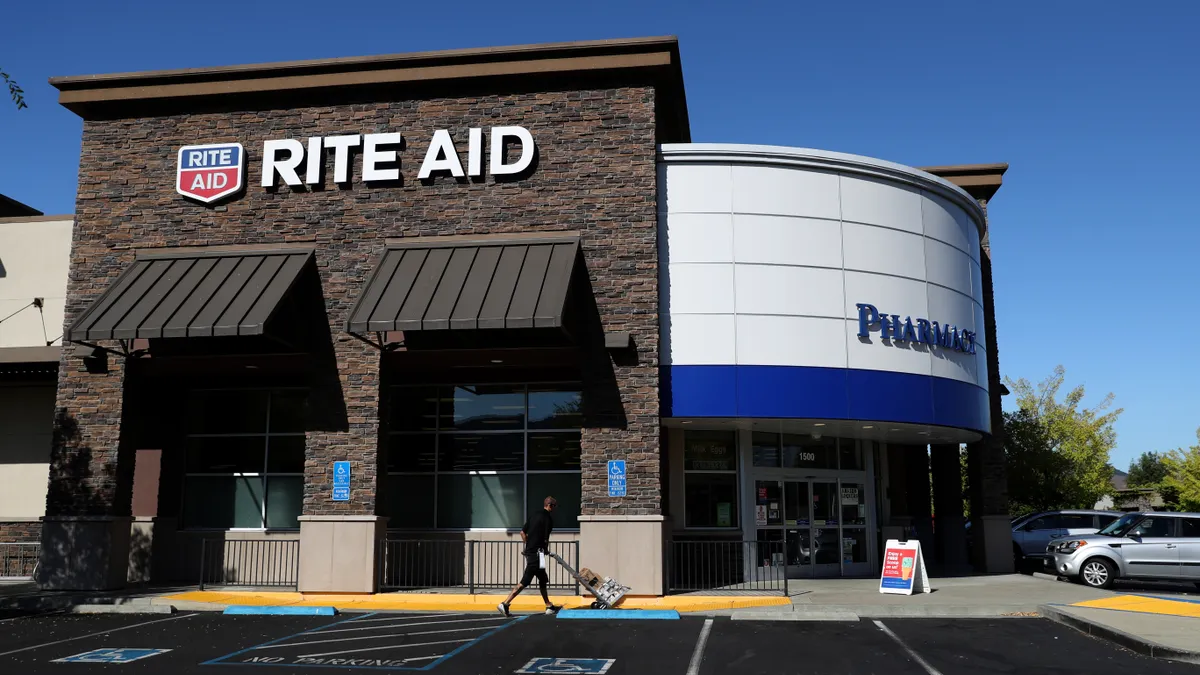Dive Brief:
- Aggressive cost-cutting measures failed to save beleaguered pharmacy chain Rite Aid from filing Chapter 11 bankruptcy this week, according to filings with the United States Bankruptcy Court for the District of New Jersey.
- The seventh-largest pharmacy chain announced Monday it had filed for bankruptcy protection. It took the step after facing pressures including more than a thousand opioid-related lawsuits, liquidity and trade challenges, significant debt obligations and a “sub-optimal” retail footprint, newly-appointed CEO and chief restructuring officer Jeffrey S. Stein noted Monday in a declaration in support of the chain’s Chapter 11 petitions.
- Rite Aid is filing for bankruptcy as distress in the healthcare sector has spiked — in the first half of 2023, 17 healthcare companies ranging from hospitals and startup drug developers filed for Chapter 11 bankruptcy, CFO Dive previously reported. Meanwhile, disruption stemming from e-commerce has continued to hammer parts of the retail sector, with Bed Bath & Beyond filing for bankruptcy earlier this year.
Dive Insight:
Stein, who has served numerous tenures as CEO and CRO for companies including Liberty Steel and Philadelphia Energy, was appointed to his roles at the Philadelphia, Pennsylvania-based company Sunday effective immediately as it looked to move forward with its plans for restructuring, according to a company press release.
Stein is taking the helm in the face of several failed efforts by the chain — which operates more than 2,100 pharmacies across 17 states — to reduce its costs and execute on turnaround initiatives to bolster the business. The company has taken steps in recent years to reduce its interest expense — Rite Aid pays approximately $200 million annually in interest, Stein said — through several strategic debt paydowns, including that of $280 million of second-lien notes due in 2025, $52 million of unsecured notes due in 2027, and $27 million of unsecured notes due in 2028.
Other cost-saving measures have included closing more than 200 “underperforming” stores and the restructuring of its executive and managerial teams, as well as the sale of owned properties in 2021, 2022 and 2023, according to the filing.
The company closed several of its stores in an attempt to cut down expenses during the first quarter of its fiscal 2024, then-interim CEO Elizabeth "Busy" Burr said during the company’s earnings call in June. Rite Aid reported a net loss of $306.7 million for its first quarter of fiscal 2024, compared to a net loss of $110.2 million in the same period the previous year.
The company also made several executive hires this year as it moved to prop up the business, hiring a new chief legal officer in June and a new chief marketing officer in August, according to company press releases.
In April, the company’s board also approved a retention incentive agreement for CFO Matthew Schroeder, affording Schroeder — who has served as CFO since 2019 — a lump sum cash payment of $1.5 million “in recognition of his criticality to the Company’s business,” according to a filing with the Securities and Exchange Commission.
The sum could potentially be an incentive for Schroeder to stay through the company’s restructuring, as “a bankruptcy is a bruise to anyone’s resume, especially a CFO,” Shawn Cole, president of boutique executive search firm Cowen Partners told CFO Dive in an email in response to questions. “This makes it a bit more palatable.”
These efforts ultimately failed to brace the pharmacy chain against multiple financial and legal pressures which culminated in this week’s declaration of bankruptcy; Rite Aid has struggled to offload its $4 billion in funded debt obligations, which have limited its liquidity and hamstrung its ability to execute turnaround initiatives, Stein noted.
Liquidity was further constrained by Rite Aid’s heavy reliance on trade credit, he said, which contributed to the loss of more than “$100 million in liquidity to trade contraction in September and early October,” per the filing. It has also strained to offload real estate costs despite closing hundreds of its stores, leaving it “burdened by $80 million in annual ‘dead rent’ costs because of its inability to exit the underlying leases outside of Chapter 11,” even when it has closed stores, Stein said.
Moreover, Rite Aid’s “significant litigation portfolio” also proved a drain on company resources and executive time, Stein said in his declaration, pointing to the more than 1,600 opioid-related lawsuits which are currently ongoing against the chain.
The suits have been consolidated into a multidistrict litigation in the state of Ohio, The Wall Street Journal reported. They join a civil suit filed by the Department of Justice in March, which alleges that Rite Aid “knowingly filled” prescriptions for controlled substances and that pharmacists “repeatedly filled prescriptions for controlled substances with obvious red flags.”
Rite Aid, which has denied that it filled illegal prescriptions for controlled substances and asked to dismiss the DOJ’s suit, is expected to treat the opioid claims as unsecured claimants in its bankruptcy, the Wall Street Journal also reported.
Rite Aid noted that “in connection with the court-supervised process we intend to close certain underperforming stores to further reduce rent expense and strengthen overall financial performance” in an emailed statement sent to CFO Dive, but declined to comment further past details included in its press releases. On a webpage dedicated to its restructuring plan, the company noted that the court-supervised process will provide a forum for the comapny to “resolve litigation claims in an equitable manner.”
The DOJ declined to comment. Michael Sirota, managing partner at Cole Schotz — who filed the bankruptcy petition on behalf of Rite Aid — did not immediately respond to requests for comment.











